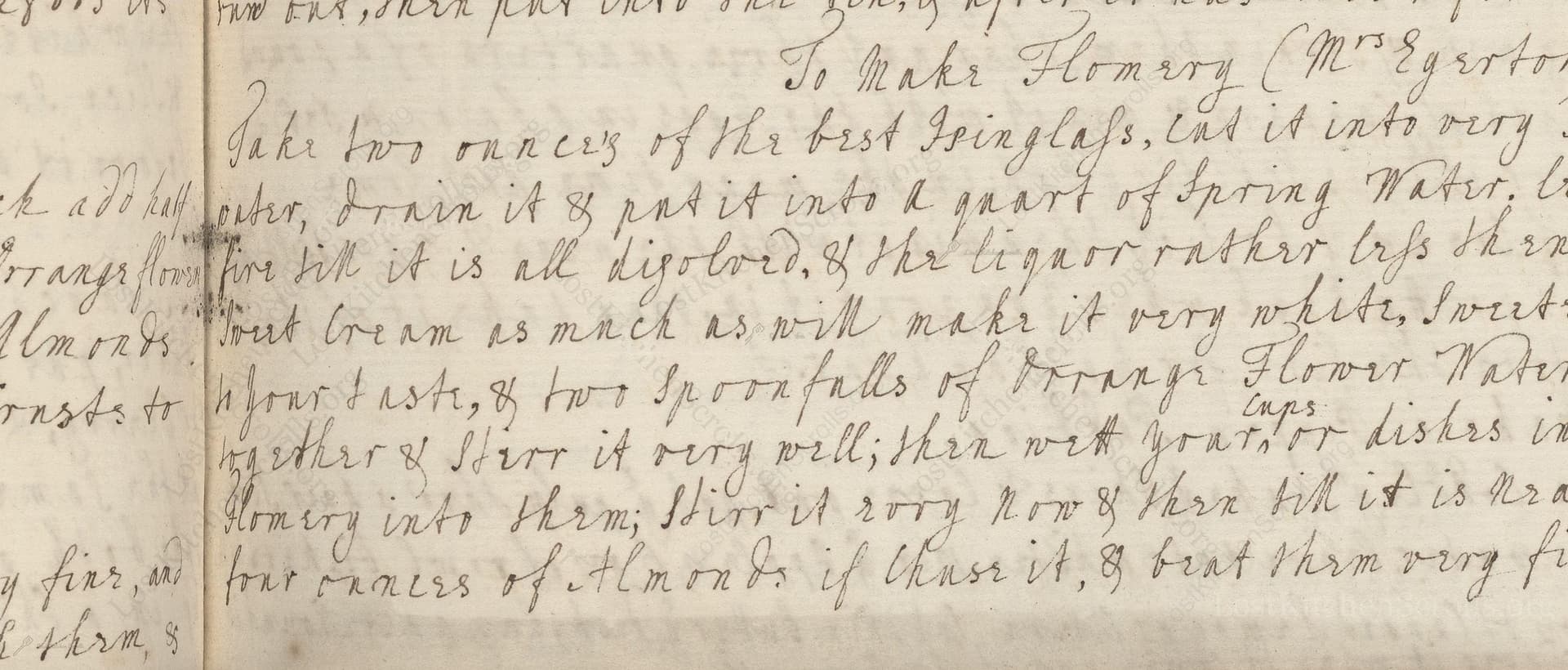To Make Flomery (Mrs Egerton)
From the treasured pages of Cookbook of 1720 approximately
Unknown Author

To Make Flomery (Mrs Egerton)
"Take two ounces of the best Isinglass, cut it into very Small pieces, wash it in Spring water, drain it & put it into a quart of Spring Water, let it boil over a very Clear fire till it is all disolved, & the liquor rather less then a pint, put to it fine thick Sweet Cream as much as will make it very white, Sweeten it with refined Sugar to your taste, & two Spoonfulls of Orange Flower Water, give all these a boil together & Stirr it very well; then strain it with your cups or dishes in Cold Water, & pour the flomery into them; Stirr it very now & then till it is near cold: You may add four ounces of Almonds if you will; blanch it, & beat them very fine."
Note on the Original Text
Like most early 18th-century manuscripts, the recipe is written as a chain of instructions with minimal punctuation and highly variable spelling—'disolved' for dissolved, 'Stirr' for stir. Quantities are sometimes vague ('as much as will make it very white'), relying on the cook’s judgment and familiarity with the process. Ingredients like isinglass and orange flower water were household staples for ambitious cooks, though rare today. The optional addition of ground almonds hints at the period's taste for enriched, textural desserts.

Title
Cookbook of 1720 approximately (1720)
You can also click the book image above to peruse the original tome
Writer
Unknown
Era
1720
Publisher
Unknown
Background
A delightful window into early 18th-century kitchens, this historical culinary tome brims with recipes, culinary wisdom, and the flavors of a bygone era—offering food enthusiasts a taste of both tradition and intrigue.
Kindly made available by
Folger Shakespeare Library
This recipe for 'Flomery' (a variant of flummery) dates to around 1720, an era when elaborate, jelly-like desserts were fashionable in English households of means. The use of isinglass—a gelatin derived from fish bladders—provided the necessary set for such sweets before powdered gelatin became common. Spring water and orange flower water reflect both the status-conscious sourcing of ingredients and the love of delicate, perfumed flavors in early 18th-century dining. This recipe was likely made for social gatherings where setting a delicate, opaque jelly in elegant molds would delight guests. Adding blanched almonds would give extra richness and mark it as a dessert for special occasions.

Cooks in 1720 would employ a small kettle or saucepan for dissolving isinglass, an open hearth or fire for heating, and simple wooden spoons for stirring. Ingredients were strained through a linen cloth or fine sieve. The flomery was set in deep china cups, ceramic bowls, or decorative molds, all pre-chilled in cold water to help release the jelly. Blanching and grinding almonds required a mortar and pestle.
Prep Time
10 mins
Cook Time
30 mins
Servings
6
We've done our best to adapt this historical recipe for modern kitchens, but some details may still need refinement. We warmly welcome feedback from fellow cooks and culinary historians — your insights support the entire community!
Ingredients
- 2 oz isinglass (or 3 tsp powdered gelatin as substitute)
- 1 qt fresh water
- 1 cup double cream (whipping cream)
- 2–3 tbsp caster sugar (adjust to taste)
- 2 tbsp orange flower water
- Optional: 4 oz blanched almonds, finely ground
Instructions
- Begin by taking 2 ounces of isinglass (or substitute with 3 teaspoons powdered gelatin if isinglass is unavailable) and cut into small pieces.
- Rinse them in fresh, cold water, then drain.
- Place into a saucepan with 1 quart of fresh water, and bring to a gentle simmer over medium heat until fully dissolved and reduced to just under 1 pint.
- Add enough double cream (whipping cream) to turn the mixture a milky white—about 1 cup should do.
- Sweeten to taste with caster sugar (about 2–3 tablespoons).
- Stir in 2 tablespoons of orange flower water.
- Bring the entire mixture to a brief boil, stirring constantly.
- Strain through a fine sieve into cups or molds that have been briefly dipped in cold water.
- Stir occasionally as it cools.
- Optional: add 4 ounces of blanched, finely ground almonds to the mixture before boiling, for a richer flavor and texture.
Estimated Calories
200 per serving
Cooking Estimates
You will need about 10 minutes to get your ingredients and workspace ready. Cooking will take about 30 minutes, mostly allowing the gelatin to dissolve and the mixture to reduce. Each serving has about 200 calories, and the recipe makes 6 servings.
As noted above, we have made our best effort to translate and adapt this historical recipe for modern kitchens, taking into account ingredients nowadays, cooking techniques, measurements, and so on. However, historical recipes often contain assumptions that require interpretation.
We'd love for anyone to help improve these adaptations. Community contributions are highly welcome. If you have suggestions, corrections, or cooking tips based on your experience with this recipe, please share them below.
Join the Discussion
Rate This Recipe
Dietary Preference
Culinary Technique

Den Bockfisch In Einer Fleisch Suppen Zu Kochen
This recipe hails from a German manuscript cookbook compiled in 1696, a time whe...

Die Grieß Nudlen Zumachen
This recipe comes from a rather mysterious manuscript cookbook, penned anonymous...

Ein Boudain
This recipe comes from an anonymous German-language manuscript cookbook from 169...

Ein Gesaltzen Citroni
This recipe, dating from 1696, comes from an extensive anonymous German cookbook...
Browse our complete collection of time-honored recipes



